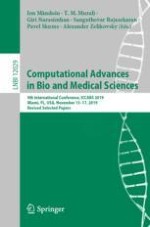2020 | OriginalPaper | Buchkapitel
FastFeatGen: Faster Parallel Feature Extraction from Genome Sequences and Efficient Prediction of DNA \(N^6\)-Methyladenine Sites
verfasst von : Md. Khaledur Rahman
Erschienen in: Computational Advances in Bio and Medical Sciences
Aktivieren Sie unsere intelligente Suche, um passende Fachinhalte oder Patente zu finden.
Wählen Sie Textabschnitte aus um mit Künstlicher Intelligenz passenden Patente zu finden. powered by
Markieren Sie Textabschnitte, um KI-gestützt weitere passende Inhalte zu finden. powered by
Abstract
FastFeatGen, emphasizing both developing a parallel feature extraction technique and improving accuracy using machine learning methods. We have implemented our feature extraction approach using shared memory parallelism which achieves around 10\(\times \) speed over the sequential one. Then we have employed an exploratory feature selection technique which helps to find more relevant features that can be fed to machine learning methods. We have employed Extra-Tree Classifier (ETC) in FastFeatGen and performed experiments on rice and mouse genomes. Our experimental results achieve accuracy of 85.57% and 96.64%, respectively, which are better or competitive to current state-of-the-art methods. Our shared memory based tool can also serve queries much faster than sequential technique. All source codes and datasets are available at https://github.com/khaled-rahman/FastFeatGen.